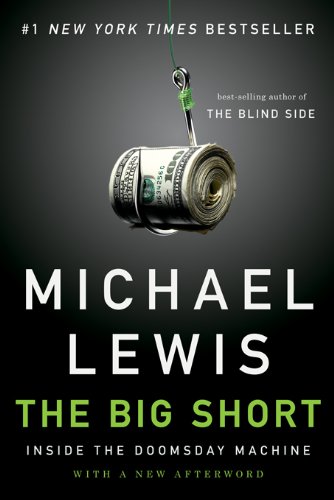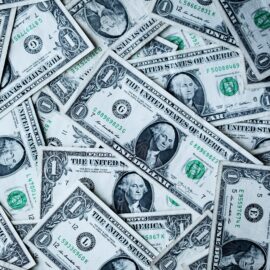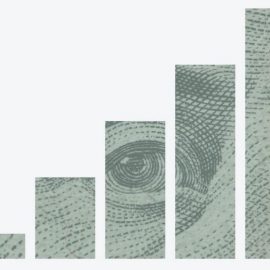

This article is an excerpt from the Shortform summary of "The Big Short" by Michael Lewis. Shortform has the world's best summaries of books you should be reading.
Like this article? Sign up for a free trial here .
What events led up to the 2008 bank bailout? Did Wall Street deserve to be bailed out? What was the true bank-bailout cost? Who paid it?
We’ll cover the events leading up to the 2008 bank bailout (also known as the Troubled Asset Relief Program, part of the Emergency Economic Stabilization Act) and how it hurt the American taxpayer.
Events Leading Up to the Bank Bailout
The complexity of financial instruments such as CDOs helped the banks continue to fool the markets, even as the true worth of these CDOs was plummeting. No one on Wall Street really understood these products, how they worked, or what was in them. There was total asymmetry of information, with the information mismatch heavily favoring the likes of Goldman Sachs. Thus, the banks were able to dictate the terms of an inefficient market. The prices of CDOs were whatever the banks said they were. Almost nobody had the knowledge (or was willing to do the work) to question this. Even the SEC (Securities and Exchange Commission), ostensibly Wall Street’s beat cop, had no clue what was going on with these derivatives.
These financial products that no one understood would seem to spell doom for the financial system. If the system collapsed, the banks wouldn’t be able to pay investors who had bought credit default swaps. They would be in need of a bank bailout. But could they continue fooling the market? If they couldn’t, could they depend on the government to bail them out?
The Contagion Spreads
The fiction couldn’t be maintained forever. Eventually, the big players on Wall Street began to feel the pain. In June 2007, Bear Stearns announced that it had lost $3.8 billion on subprime mortgage securities. Cornwall Capital, an investment firm, should have been delighted, as they had bought most of the credit default swaps from Bear. What was bad news for the investment bank was surely good news for Cornwall. But there was a hitch: Bear had taken such a beating that they might not have the liquidity to actually pay Cornwall the face value of the bonds that the latter had insured.
The exposure to the fallout from subprime wasn’t just limited to Bear Stearns. British bank HSBC also announced in 2007 that they had taken major losses in their subprime lending business. These bonds were like a virus that had infected all of the major financial firms. And given the complexity of the CDOs, very few people inside or outside these firms could tell exactly how much exposure they had to subprime. No one knew for sure just how much of these toxic assets were littered across the balance sheets of the world’s leading financial institutions. Eisman was continually struck by just how foolish and inept so many CEOs at financial institutions really were. The Masters of the Universe were clueless: the emperor had no clothes.
When Morgan Stanley finally admitted defeat and exited the trade, they had lost a net $9 billion, the single largest trading loss in Wall Street history. By the end of 2007, the bank lost over $37 billion through the subprime mortgage bond and related derivatives market. In an infamous conference call with shareholders, Morgan Stanley CEO John Mack revealed that he had zero understanding of what his bond department had been up to. The game had grown too complex for even the titans of Wall Street themselves to understand. Total losses on U.S. subprime-related assets would eventually top $1 trillion.
The Final Sucker: You
The investors all believed that they were getting one over on the big banks. Through greed, short-sightedness, and outright stupidity, they believed that Wall Street had been given enough rope to hang itself.
But, in the end, this wasn’t really true. Yes, investors Eisman, Burry, Lippmann, Ledley, Mai, and Hockett were vindicated and got paid. But the final payer wasn’t Goldman Sachs or Deutsche Bank or AIG or Morgan Stanley. It was the U.S. taxpayer.
When the final meltdown occurred in September 2008, Congress passed the Troubled Asset Relief Program (TARP), the (in)famous $700 billion bank bailout of the financial sector. The gains, it turned out, were privatized—the losses were socialized. Wall Street was pro-free market until they were in trouble. As John Gutfreund, former CEO of Salomon Brothers remarked, “It’s laissez-faire until you get in deep shit.”
The $13 billion that AIG had lost to Goldman Sachs betting on subprime mortgage bonds was fully covered by the government. Likewise, the Treasury Department guaranteed $306 billion of Citigroup’s assets (equivalent to nearly 2 percent of total U.S. GDP). The U.S. government decided that it could not allow all of Wall Street to go under: the toxic subprime assets were spread too far, too wide, and too ambiguously. If one firm needed a bailout, they all needed a bailout.
Did the big banks know that they were too big to fail and that they would receive a bank bailout no matter what kind of irresponsible risks they took? And did this knowledge bring on the excessive risk-taking? It’s certainly easy to gamble when you know you’re playing with the house’s money. Our collection of esoteric investors had keen insights that few in the period from 2005-2008 had. But what they didn’t know is that the public—all of us—would be the ones ultimately on the hook.
———End of Preview———

Like what you just read? Read the rest of the world's best summary of "The Big Short" at Shortform . Learn the book's critical concepts in 20 minutes or less .
Here's what you'll find in our full The Big Short summary :
- How the world's biggest banks contributed to the 2008 financial crisis, greedily and stupidly
- How a group of contrarian traders foresaw the bubble popping, and made millions from their bets
- What we learned from the 2008 crisis - if anything




![Is the World Getting Better or Worse? [Statistics] Is the World Getting Better or Worse? [Statistics]](https://www.shortform.com/blog/wp-content/uploads/2019/07/factfulness-earth-270x270.jpg)

